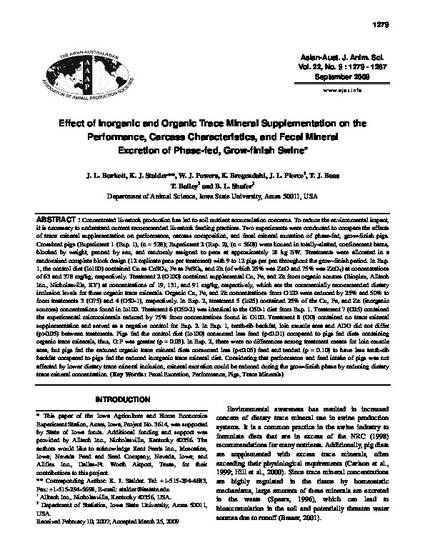
Concentrated livestock production has led to soil nutrient accumulation concerns. To reduce the environmental impact, it is necessary to understand current recommended livestock feeding practices. Two experiments were conducted to compare the effects of trace mineral supplementation on performance, carcass composition, and fecal mineral excretion of phase-fed, grow-finish pigs. Crossbred pigs (Experiment 1 (Exp. 1), (n = 528); Experiment 2 (Exp. 2), (n = 560)) were housed in totally-slatted, confinement barns, blocked by weight, penned by sex, and randomly assigned to pens at approximately 18 kg BW. Treatments were allocated in a randomized complete block design (12 replicate pens per treatment) with 9 to 12 pigs per pen throughout the grow-finish period. In Exp. 1, the control diet (Io100) contained Cu as CuSO4, Fe as FeSO4, and Zn (of which 25% was ZnO and 75% was ZnO4) at concentrations of 63 and 378 mg/kg, respectively. Treatment 2 (O100) contained supplemental Cu, Fe, and Zn from organic sources (Bioplex, Alltech Inc., Nicholasville, KY) at concentrations of 19, 131, and 91 mg/kg, respectively, which are the commercially recommended dietary inclusion levels for these organic trace minerals. Organic Cu, Fe, and Zn concentrations from O100 were reduced by 25% and 50% to form treatments 3 (O75) and 4 (O50-1), respectively. In Exp. 2, treatment 5 (Io25) contained 25% of the Cu, Fe, and Zn (inorganic sources) concentrations found in Io100. Treatment 6 (O50-2) was identical to the O50-1 diet from Exp. 1. Treatment 7 (O25) contained the experimental microminerals reduced by 75% from concentrations found in O100. Treatment 8 (O0) contained no trace mineral supplementation and served as a negative control for Exp. 2. In Exp. 1, tenth-rib backfat, loin muscle area and ADG did not differ (p>0.05) between treatments. Pigs fed the control diet (Io100) consumed less feed (p<0.01) compared to pigs fed diets containing organic trace minerals, thus, G:F was greater (p = 0.03). In Exp. 2, there were no differences among treatment means for loin muscle area, but pigs fed the reduced organic trace mineral diets consumed less (p<0.05) feed and tended (p = 0.10) to have less tenth-rib backfat compared to pigs fed the reduced inorganic trace mineral diet. Considering that performance and feed intake of pigs was not affected by lower dietary trace mineral inclusion, mineral excretion could be reduced during the grow-finish phase by reducing dietary trace mineral concentration.
Available at: http://works.bepress.com/kenneth_stalder/182/

This article is published as Burkett, J. L., K. J. Stalder, W. J. Powers, K. Bregendahl, J. L. Pierce, T. J. Baas, T. Bailey, and B. L. Shafer. "Effect of Inorganic and Organic Trace Mineral Supplementation on the Performance, Carcass Characteristics, and Fecal Mineral Excretion of Phase-fed, Grow-finish Swine." Asian-Australasian Journal of Animal Sciences 22, no. 9 (2009): 1279-1287. doi: 10.5713/ajas.2009.70091 . Posted with permission.